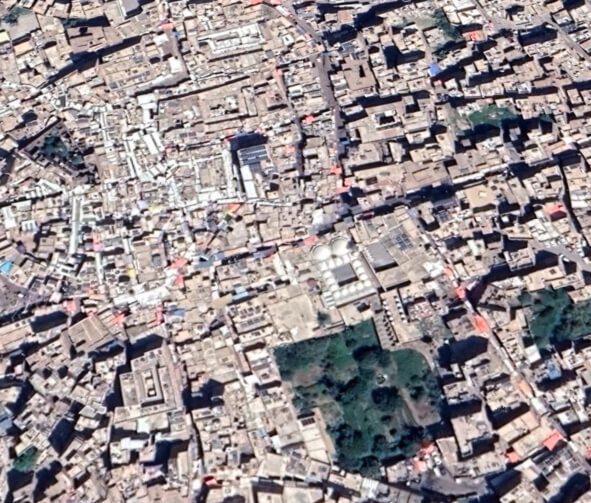
Al-Madhhab Mosque – Old Ṣan‘ā’
جامع المذهب- صنعاء القديم ة
Monument description
Al-Madhhab Mosque is one of the Mosques built south of the Salt Market and east of the Jinnah Mosque. The Mosque is located in the Madhhab district, and named after it. It is located south of the qat market and surrounded by a number of houses, roads and service facilities. It is accessed from the western side through an alley extending north from Suq Al-Qat Street. This alley is bounded on the east by the Madhhab Mosque and on the west by the Jinnah Mosque. The alley ends on the south at the Al-Mutahhar Mosque with a Jinnah. This corridor overlooks the western wall of the courtyard of the Mosque, and in the middle is the entrance to the courtyard. The Mosque is also accessed through Ramsay Street from the eastern side overlooking the eastern entrance to the Prayer Hall. To get acquainted with the geography of this Mosque and the directions of movement, we will take a look at the borders of the Mosque. The Mosque is bordered on the eastern side by Ramsay Street and a group of private houses. To the west is the Jinnah Mosque and the alley in between, and to the south is Makshamah Al-Humaidi — a garden or orchard in which vegetables are grown with a number of fruit trees and aromatic plants.

Architectural and cultural value
Construction style and built date: The design of the Prayer Hall is a rectangular building with a flat roof supported by a series of vaulted vaults. The construction period of this Mosque dates back to 1085 AH. During the Ottoman rule in Yemen, a number of Ottoman governors expanded the Mosque.
Components of the Mosque: A Mosque, a courtyard, two sheds and its annexes, a water system made up of modern bathrooms, and the Minaret and Al-Mataher in common with the Al-Juna Mosque. The monument area is 780 m².
- Justifications for intervention:
- The building has been neglected for lack of funding. The building has been neglected for lack of funding.
- 1. Preserving the monument and preventing further damage
- 2. Restoration of damages to the Mosque resulting from the air strikes to the northern part of the Old City of Sana‘a
- 3. Contribute to the restoration of damaged monuments in a proper manner in order to keep Old Sa-na‘a in the World Heritage List
- Monument conditions:
- The historical monument is generally in good condition. However, there are clear signs of damages:The historical monument is generally in good condition. However, there are clear signs of damages:
- Serious damages
- 1. Mihrab wall
- 2. The lower rows of the walls of the Prayer Hall, especially in the eastern and northern walls which façades are blocked by houses and added shops, preventing sun and ventilation and allowing rainwater to seep into the building structure
- 3. Many stone blocks, especially limestone, in the lower rows were subjected to disintegration of their texture, resulting in poor cohesion.
- Processing in this case
- 1. Renovation of the foundations and walls damaged by moisture due to rain, and removing the source of the damage.
- 2. Restoration of the gutter in the western wall and removal of the cemented part.
- 3. Removing the deformations of cement that occur on the external walls and replacing it with Qudad.
- 4. Restoration of the damaged areas in the minaret and carving it in the old style.

Countries










